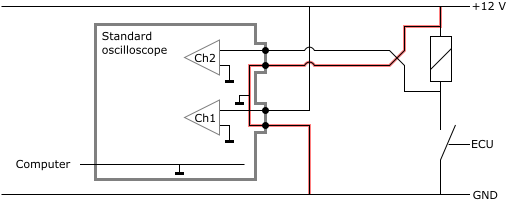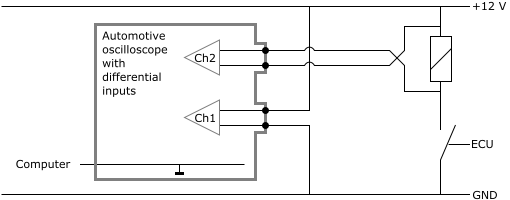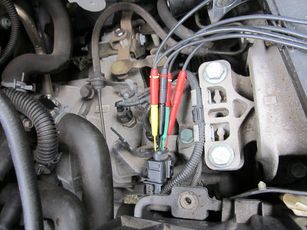An automotive oscilloscope with differential inputs avoids damaging car electronics as result of a wrong connection during measuring.
No differential inputs
In a standard automotive oscilloscope without differential inputs, the ground terminals of all input channels are connected to each other. When channel 1 of the automotive oscilloscope is used to measure the battery voltage and channel 2 e.g. a positive driven injector, a large short circuit current can flow. This short circuit current can occur when the ground terminal of channel 2 is accidentally connected to the injector. This large current can damage both the car wiring as well as the car electronics. Because of using an automotive oscilloscope without differential inputs, much damage is caused as result of connecting the automotive oscilloscope wrong.

With differential inputs
An automotive oscilloscope like the Automotive Test Scope ATS610004D-XMSG and Automotive Test Scope ATS5004D has differential input channels. The ground terminals of the inputs are not connected to each other and also not connected to the ground of the PC. When the instrument is accidentally connected wrong, there will flow no short circuit current and expensive extra repairs because of damaged car electronics are history.

Using additional tools
When besides the automotive oscilloscope also e.g. a fault code scanner is connected to the computer, differential inputs on the automotive oscilloscope are even more important.
The fault code scanner is connected to the ground of the car battery and also to the ground of the computer. With a standard automotive oscilloscope, the input channels are connected to the ground of the battery. When the fault code scanner is connected to the car, and the ground of an input channel of the automotive oscilloscope is accidentally connected to the plus of the car battery, both the computer and the fault code scanner will be damaged by the very large short circuit that will flow.
Conclusion

With an automotive oscilloscope with differential inputs, these problems never occur because:
- the ground terminals of the input channels are not connected to each other
- both input and ground terminal of each input channel have a high input impedance (1 MOhm for the Automotive Test Scope ATS610004D-XMSG and Automotive Test Scope ATS5004D)
It is therefore highly recommended to always use an automotive oscilloscope with differential inputs to avoid short circuits and expensive damage to the car electronics.
